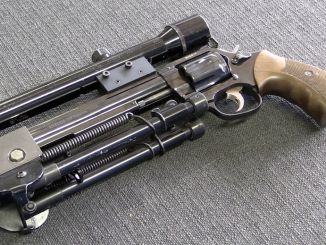Colonel Jean Alexandre LeMat was a native Frenchman who emigrated to the United States and in 1856 secured a patent for a “grapeshot revolver”, which had both a 9-shot .42 caliber cylinder and a 20-gauge smoothbore barrel acting as the cylinder axis. A moveable striking surface on the hammer allowed the user to alternate between firing the rounds in the cylinder and the center shotgun barrel. Unable to find a manufacturer in the US, LeMat had them manufactured in Belgium. These revolvers achieved most of their current notoriety as a result of several thousand being used by the Confederate States of America during the American Civil War – and those guns were percussion ones. However, LeMat also made a smaller number of pinfire variants for sale in Europe (where pinfire cartridges were much more common than in the Americas). This LeMat revolver is one of the pinfire examples, which still has a 9-shot cylinder and retains the percussion mechanism for the center smoothbore barrel. It comes in its original case, with several tools including a mold to make an interested 3-part segmented slug.
Related Articles

Prototype
Colt Offensive Pistol at RIA
I had the opportunity to visit Rock Island Auction again to check out the guns they have up for sale in their December 2014 Premier Auction, and put together a big batch of videos, which […]

Light MGs
Slow Motion: .303 Lewis Gun
A Lewis Gun, in .303 British, at 2000 frames per second: The Lewis Gun was developed by American Isaac Newton Lewis shortly before WWI, but the US military was not interested in it (in part […]

Revolver
GIGN’s MR73 Sniper Revolver in .357 Magnum
Courtesy of the French Ministry of the Interior, we have a chance to take a look at an authentic GIGN sniper model MR73 revolver today. GIGN is the elite intervention element of the French Gendarmerie, […]

thats a beauty
What LeMat should have made was a 9 shot centerfire pistol, with the breech loading percussion shotgun as he did with the pinfire. This is the first hybrid of cartridge and cap I’ve ever seen, but it should work.
As Long as the shotgun barrel is kept percussion, it seems to me that a modern centerfire revolver application of this concept would be legal, would it not?
Another way to make it legal in the US (except California) would be, I believe, make the center barrel rifled and chambered for .410 shot shells. Of course you would then have to switch to a break-open design in order to load the thing.
I am thinking .22 WMR for the regular cylinder chambers and a 6-7″ main barrel. That should give you a fair number of shots (probably at least 10+1) and about .38 Special equivalent muzzle energy for the .22 WMR. Now, who would make such a thing? (Probably no one, sadly way too risky).
You are correct that a .45/.410 centerfire barrel would be a legal way to do it, but a 16 or 20 gauge would be SO much more fun…
There’s an interesting bit in S. M. Stirling’s “The Peshwar Lancers” (really fun – if you are an H. Rider Haggard fan – bit of cyberpunk alternative history about life a hundred years after comet debris hits Europe and North America; all the Brits move to India and the French move to Algeria) that you have to be a gun nerd to pick up on. A Frenchman, riding with the Lancers along the Afghan border, pulls out and cuts loose with a semi-modern version of a LeMat to the dismay of the attacking tribesmen.
One time when I was living in a place with fairly tight gun laws I kept a Ruger Old Army capped and loaded next to my bed and always felt fairly well protected, but the reproduction LeMats that Cabella’s was selling a few years ago would have been even better. However, as I learned from a YouTube video about the repros, one problem is that the shotgun barrel is a couple of inches shorter than the revolver barrel so using the 20-guage messes up the finish of the longer barrel. Still, it’s interesting to think of the shotgun-revolver combo as a 19th century version of the M203 with a beehive round in the grenade launcher.
“He’s out of shots! Get him!” BOOM!
That had to hurt, right? Could one make a separate trigger group for the shotgun charge and still have this revolver work?
Something I just noticed, the case is built the opposite way from most cases, ie. the pistol or case hinges are ‘upside down’.
When I was in grad school, a buddy of mine invited me over to his place to look at his collection. He had a few nice pieces, but nothing special. Then, he brought out a large wooden case. Inside were a pair of LeMats that belonged to his great-grandfather who was a former Confederate general and leader of the postwar “vigilance committee.” His family still had a ton of political stroke, even after all those years. Needless to say, I was floored. I offered him my F-150 Ford pickup in trade, and he just laughed.
No, the case is correct for a right-handed shooter. In this configuration all that is required to put the pistol into action is to reach into the case, pick the pistol up by the grip with your right hand and your “trigger finger” inside the trigger guard, cock the hammer and fire. This is much faster than having to swap the pistol around to bring it into play. The reverse position is for display effect and not practical for actual self/home defense usage. The pistol was stored in the case to keep the whole “kit” together. This is from my grandfather, James Monroe Johnson of Mena, Arkansas long ago. This is the way he stored his 1873 .41 cal. Colt single action revolver for decades.